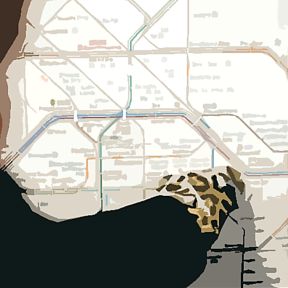COGNITION- Your Thinking Should Remember 'The Map Is Not the Territory'. Critical thinking on a road to nowhere. Reviewed by Hara Estroff Marano

I read an interesting piece the other day addressing Korzybski’s (1931) concept, ‘the map is not the territory’ and its implications in realms like commerce. In a particularly simplified manner (oh, the irony), the gist of the concept is that a map is not the same as the territory it represents—it differs in scale, it fails to account for changing nuance, and, in some cases, it suffers from projection issues. It represents something similar—a representation as accurate as the people who develop it can get it—but it’s just not the same.

As my grandfather used to say, ‘if you’re going to do it, do it right’, so, if the map’s not right, why bother? Well, it’s simple. Despite their shortcomings, maps are extremely useful, simplifying geography and travel being the most obvious examples. For most practical uses, it really just needs to be close enough.
Moving forward, a map is an abstraction—lines drawn on paper—that represents the concrete, such as the Earth’s terrain. It is a model. The gist of the analogy—an abstraction in its own right— is that the representative models and abstract ideas we develop, say in research, are not perfect, often far from. Yes, some are much better than others; but, nevertheless, imperfect.
For example, in physics, Shrödinger’s Cat is a thought experiment, an abstraction describing a cat in a box—one that could be alive… or it could be dead. We don’t know, and we won’t know until we look inside the box. But, until we do, we must consider that the cat could be both. This "reduction" is used to illustrate complex concepts associated with quantum superstition and the double-slit experiment. As commonly attributed to Richard Feynman, "if you think you understand quantum mechanics, you don’t understand quantum mechanics" is a quote describing the counterintuitive nature of the field in comparison with traditional, classical (e.g. Newtonian) physics. Thus, given both the complexity and, in many cases, confusion associated with many concepts in quantum mechanics, we get these abstractions— like a story about a cat in a box, to help us understand the concept on a good-enough basis (e.g. satisficing; see Simon, 1957).
Allusion to Herbert Simon here facilitates the association I’m making here to psychological implications. We like abstractions because they simplify the world around us—much like cognitive schemas—as mental frameworks for how we interpret our world, providing us maps for navigating information processing.
Of course, the association with psychology goes above and beyond that of how one individual thinks. It actually applies to why we, as large populations, gravitate towards thinking the way we do, regardless of our inclinations for thinking critically. For example, society shares common beliefs and expressions that we apply every day—"it is what is", "such is life", "everything happens for a reason". These abstractions are used to more easily explain the unexplainable. Of course, their vague nature keeps them from representing any real model; rather, just things we say to progress our interactions and facilitate coping and/or "understanding".
On the other hand, we develop models to explain abstractions on a theoretical basis in research (akin to Shrödinger’s Cat). For example, in another past post, I discuss how a theory is more than just an educated guess: It’s an established model for why or how a given phenomenon occurs, it is an explanation of observed regularities. Gravity is among the most common examples here, in that the concept, in everyday settings, is a model representing acceleration towards the Earth at 9.81 m/s2. Of course, people typically think of it in even simpler terms: "What goes up must come down".
In other research cases, we have many distinct models for why a phenomenon occurs; for example, in terms of why people at times act in altruistic manner, there’s explanations regarding kin selection, reciprocity, cost-benefit analysis (e.g. social exchange), trait inheritance, and empathy (to name a few). In a situation like this, one might ask, which is it? As I note regularly on this blog, as in all of my social psychology classes, you can never go wrong with the answer "it depends’" It’s this notion that, arguably, gets to the core of "the map is not the territory" issue.
Consider a physical map you’ve encountered. Time has passed between its publication and your viewing of it. The terrain is likely different. There might be a new road built. Land might have eroded. A parking lot might have replaced a field. The context is different.
Back to cognitive science: We know humans use schemas and heuristics to guide information processing and decision-making, but reliance on these for important decisions is not a good substitute for critical thinking. The terrain or context might not be the same. It might not be accurate. A decision-making roadmap, a heuristic you’ve used in the past with success, may not be successful in another situation because no two situations are the same… because the answer "depends" on the parameters of the context. Moreover, it could be the case that knowledge has changed; scientific advancements have debunked old thinking about the nature of things (e.g. Pluto no longer being a planet, as of 2006).
Again, these roadmaps are imperfect and, though good enough may satisfice for unimportant decisions, they won’t cut it for decisions that matter. As context is key, use of a pre-drawn map, schema, or heuristic for important decision-making may be a poor choice. In this sense, the analogy is a fair representation of how we engage thinking: The map is not the territory.
- Questions and Answers
- Opinion
- Motivational and Inspiring Story
- Technology
- Live and Let live
- Focus
- Geopolitics
- Military-Arms/Equipment
- Güvenlik
- Economy
- Beasts of Nations
- Machine Tools-The “Mother Industry”
- Art
- Causes
- Crafts
- Dance
- Drinks
- Film/Movie
- Fitness
- Food
- Oyunlar
- Gardening
- Health
- Home
- Literature
- Music
- Networking
- Other
- Party
- Religion
- Shopping
- Sports
- Theater
- Health and Wellness
- News
- Culture

